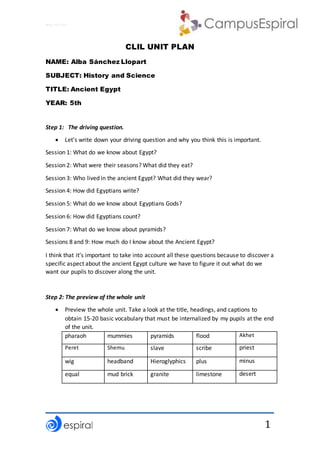
Module 1 activity clil unit plan template
- 1. Why not CLIL? 1 CLIL UNIT PLAN NAME: Alba Sánchez Llopart SUBJECT: History and Science TITLE: Ancient Egypt YEAR: 5th Step 1: The driving question. Let’s write down your driving question and why you think this is important. Session 1: What do we know about Egypt? Session 2: What were their seasons? What did they eat? Session 3: Who lived in the ancient Egypt? What did they wear? Session 4: How did Egyptians write? Session 5: What do we know about Egyptians Gods? Session 6: How did Egyptians count? Session 7: What do we know about pyramids? Sessions 8 and 9: How much do I know about the Ancient Egypt? I think that it’s important to take into account all these questions because to discover a specific aspect about the ancient Egypt culture we have to figure it out what do we want our pupils to discover along the unit. Step 2: The preview of the whole unit Preview the whole unit. Take a look at the title, headings, and captions to obtain 15-20 basic vocabulary that must be internalized by my pupils at the end of the unit. pharaoh mummies pyramids flood Akhet Peret Shemu slave scribe priest wig headband Hieroglyphics plus minus equal mud brick granite limestone desert
- 2. Why not CLIL? 2 Step 3: The easiest and hardest section of your unit. I think that the easiest session of the unit it’s Session 3: Who lived in the ancient Egypt? What did they wear? It is my belief that students who are in year 5 are already familiarized with clothes vocabulary. However, the hardest sessions of the unit are Session 6: How did Egyptians count? and Session 7: What do we know about pyramids?. In the session nº6 students will make easy sums but, they will have to know some mathematical vocabulary, which will require deeper work. And on the other hand, “pyramids” is a very motivational topic, but they will have to get familiarized with all the building material they used to use to build pyramids. Step 4: Law aspects. The LOMCE defines 7 competences: (let’s define some aspects of each competences) Linguistic competence. Mathematical competence and basic competences in science and technology. Digital competence. Learning to learn. Social and civic competences. Initiative and entrepreneurship. Cultural awareness and expression. I will include these LOMCE standards in my unit plan: (try to find it into your Autonomous Community curriculum) The two more relevant competences in the unit are: 1) The linguistic and audiovisual is probably the most important due to the necessity of a good communication during the unit. Pupils will have to understand what they are being taught in another language. They will also have to be able to speak and communicate with their classmates and the teacher in order to do the activities correctly. 2) The personal, social and civic competence. It is the one related itself with the topic: the Ancient Egypt. Our pupils will be able to learn English through History. The point is not only to learn new things about the Ancient Egypt but also to practice and learn how to use the language. However, they will have to be sensitive enough to understand the way they lived, what they ate, and their religion among other aspects.
- 3. Why not CLIL? 3 However, the other competences will be appearing in each session: For example: 1) Methodological(Mathematical): -To interpret and put into practice processes of mathematical reasoning leading to solving the problems and questions in everyday situations and in different fields to which mathematics can offer answers. 2) Personal(Autonomy, initiative and decision taking) -To develop collective activities with critical thinking. 3) Methodological: (Information handling and digital competence / Learning to learn) -To interact with digital tools in order to learn and to understand the information. -To access and communicate information using different supports including ICT tools to learn. -To transform information into knowledge activating thinking skills in order to organize, relate and analyse. -Can handle effectively an array of resources to transform information into personal knowledge. Step 5: Content Which interdisciplinary subjects could be connected to in this unit? Why and how? Language: ∙ Vocabulary related to Egypt (clothes, weather and culture). ∙ Grammar structures (comparatives and superlatives). ∙ Personal description. ∙ Egyptians gods’ description ∙ Pronunciation of typical Egypt clothing. ∙ Pyramid related vocabulary. Social science: ∙ Egypt characteristics ∙ The three different seasons. ∙ Egyptians’ food. ∙ Hieroglyphs history, meaning and use. ∙ Egyptian’s writing. ∙ Egyptians’ gods. ∙ The different groups of people of the ancient Egyptian society and what they did. ∙ Typical Egypt clothing.
- 4. Why not CLIL? 4 ∙ Pyramids history, meaning and use. ∙ Egyptian culture. Maths: ∙ The different hieroglyphics that represent each number. ∙ Mathematical expressions. ∙ Sums and Word. New technologies: ∙ Main characteristics of Glogster (to insert text, pictures, videos and sounds) Steps 6: Soft Skills. I will include these soft skills in my unit plan: o Communicative skills: listening, speaking, reading, writing o Teamwork and collaboration o Adaptability o Problem solving o Critical thinking and observation o Giving and receiving feedback o Conflict resolution
